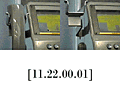Interaction 95 |
1999.09.01 |
born 1945, teaches art at Université Paris 8 and is head of the Laboratoire d’esthétique et technologie de l’interactivité. He is curator of the “Revue virtuell” exhibition of the Centre Georges Pompidou and of the biennal exhibition Artifices in Saint-Denis. As researcher and artist he has been connection with interactivity and virtuality. selected works Le Bus(1985), Pékin, Pour mémoire(1986), Globus oculi(1992), Flora petrinsularis(1994), Tabula rasa(1995) Mutatis mutandis  Mutatis mutandis is an interactive computerised installation. It’s hypermedia project realised from digitalized video images and sounds. It addresses issues concerning poetry and philosophy, and explores the language of interact ivity in the making. The title is a Latin expression, used in French as well as English that means changing what have to be changed” (or that which should be changed has been changed”). This sentence underlines a paradox: in order to make a comparison one must ignore the part of the differences that isn’t directly concerned by the comparison. The screen features a duo of images in the form of an diptych situated either in the upper half or the lower half of the scree. These images present a movement of transformation and thus display two different states of the same thing. By moving the arrow on the screen from one image to another this transformation is reproduced by the animation of the images, whereas by placing the arrow outside of the images a new diptych is displayed. The subject matter of these iamges is on the one hand singular - because it has been filmed in specific sites with specific circumstances- and on the other hand banal in that is represents everyday life and nature. During the consultation no particular theme concerning the subject emerges, except perhaps that of its interior mutations. Mutatis mutandis is an interactive computerised installation. It’s hypermedia project realised from digitalized video images and sounds. It addresses issues concerning poetry and philosophy, and explores the language of interact ivity in the making. The title is a Latin expression, used in French as well as English that means changing what have to be changed” (or that which should be changed has been changed”). This sentence underlines a paradox: in order to make a comparison one must ignore the part of the differences that isn’t directly concerned by the comparison. The screen features a duo of images in the form of an diptych situated either in the upper half or the lower half of the scree. These images present a movement of transformation and thus display two different states of the same thing. By moving the arrow on the screen from one image to another this transformation is reproduced by the animation of the images, whereas by placing the arrow outside of the images a new diptych is displayed. The subject matter of these iamges is on the one hand singular - because it has been filmed in specific sites with specific circumstances- and on the other hand banal in that is represents everyday life and nature. During the consultation no particular theme concerning the subject emerges, except perhaps that of its interior mutations.Each gesture of the viewer that provokes and repeats a mutation also changes a code number that is displayed in the empty section of the screen that indicates which new diptych sequence that viewer can, at that moment, summon up. The code that corresponds to each sequence indicates its place in the classification. The viewer is thus invited to experience a double attitude: to discover and understand the logic of the typology of mutations; observe attentively, but at a distance, a mere fragment of the complex real, that is irreducible to all description or classification. (Translated by Elizabeth Tesla) |
| interaction 95 >> |
E-Mail : info@iamas.ac.jp |
